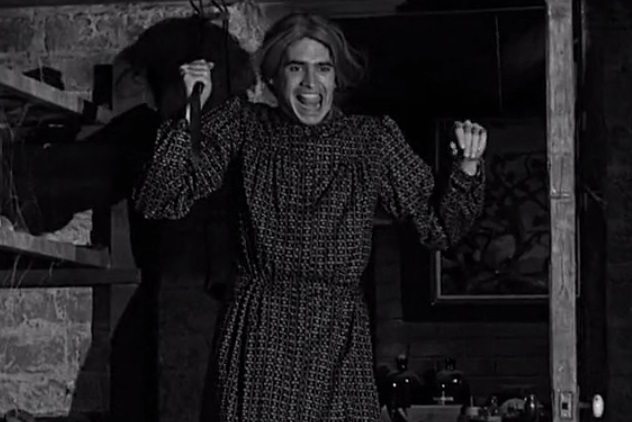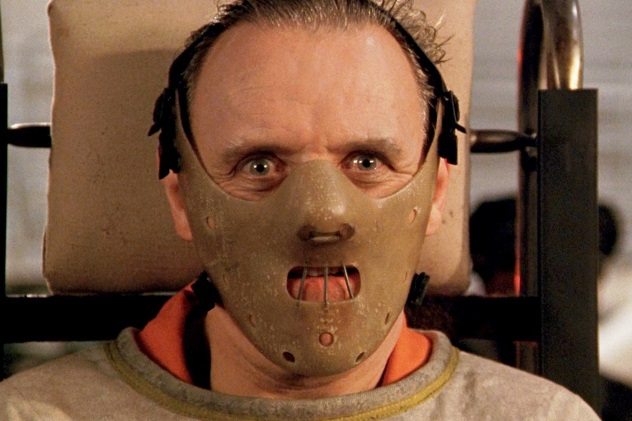 Movies and TV
Movies and TV  Movies and TV
Movies and TV  Health
Health 10 Miraculous Advances Toward Curing Incurable Diseases
 Miscellaneous
Miscellaneous 10 Undeniable Signs That People’s Views of Mushrooms Are Changing
 Animals
Animals 10 Strange Attempts to Smuggle Animals
 Travel
Travel 10 Natural Rock Formations That Will Make You Do a Double Take
 Movies and TV
Movies and TV 10 Actors Hidden in Your Favorite Movies
 Our World
Our World 10 Science Facts That Will Change How You Look at the World
 Pop Culture
Pop Culture 10 Incredible Female Comic Book Artists
 Crime
Crime 10 Terrifying Serial Killers from Centuries Ago
 Technology
Technology 10 Hilariously Over-Engineered Solutions to Simple Problems
 Movies and TV
Movies and TV 10 Movie Adaptions That Brought Popular Songs to Life
 Health
Health 10 Miraculous Advances Toward Curing Incurable Diseases
 Miscellaneous
Miscellaneous 10 Undeniable Signs That People’s Views of Mushrooms Are Changing
Who's Behind Listverse?

Jamie Frater
Head Editor
Jamie founded Listverse due to an insatiable desire to share fascinating, obscure, and bizarre facts. He has been a guest speaker on numerous national radio and television stations and is a five time published author.
More About Us Animals
Animals 10 Strange Attempts to Smuggle Animals
 Travel
Travel 10 Natural Rock Formations That Will Make You Do a Double Take
 Movies and TV
Movies and TV 10 Actors Hidden in Your Favorite Movies
 Our World
Our World 10 Science Facts That Will Change How You Look at the World
 Pop Culture
Pop Culture 10 Incredible Female Comic Book Artists
 Crime
Crime 10 Terrifying Serial Killers from Centuries Ago
 Technology
Technology 10 Hilariously Over-Engineered Solutions to Simple Problems
10 Common Misconceptions About Serial Killers
Our perception of serial killers is skewed by movies and TV shows. Hollywood has a clear image of the type of killer who resonates most with audiences, and that stereotypical view is disproportionately featured in media. Most of the following stereotypes have some basis in reality, but they are far from the norm.
10 All Serial Killers Are Men

This is a common misconception perpetuated not only by the general public but also by law enforcement professionals. In 1998, profiling pioneer and sex crimes expert Roy Hazelwood said that “there are no female serial killers.”[1] It’s true that the numbers heavily favor the men; around 85–90 percent of serial killers are male, but there are also plenty of examples of serial murderers who were female.
One possible reason for the misconception is the disinterest in female serial killers showed by the media. Most women murderers kill for profit or power. They don’t torture their victims, they don’t taunt the police, and they don’t do all kinds of gory things with the bodies. In other words, they don’t typically make the kind of terrifying villains who capture the public’s attention. It was only in 2003 that this idea was challenged by the movie Monster, which detailed the killings of Aileen Wuornos, arguably the most famous female serial killer in the world.
Even though there are fewer women who kill, it seems that they are better at it. One study suggested that murderous women have a longer “career” than their male counterparts. This is because they generally tend to avoid attention, prefer cleaner killing methods such as poisoning or smothering, and target vulnerable victims with whom they share an emotional or physical connection.
9 The United States Has A Serial Killer Epidemic

The common perception is that the US is a breeding ground for serial murderers. It’s impossible to say with certainty how many serial killers are active in the United States. The lack of connection between them and their victims can make law enforcement oblivious to their existence for decades. Former FBI Serial Crime Unit chief John Douglas gave a conservative estimate of 25 to 50 serial killers active at any given time. They are responsible for up to 150 murders annually, or approximately one percent of homicides in the US.
In case you were wondering which state has the biggest problem with serial killers, it’s not what you would expect. States like California and Florida have high total numbers of serial murders, but with an adjusted number of serial killings per one million people of 15.65, Alaska tops the list.[2]
Again, this misconception was shared by officials who should have known better. During the serial killer panic of 1983, the US Department of Justice blamed serial murderers for the large increases in homicides during the 1970s and 1980s compared to the early 1960s. They estimated that serial killers were responsible for up to 5,000 homicides per year. This number was nowhere close to reality, not even in the 1980s, which was the worst decade for serial murder. This statistic was perpetuated for a while before being rectified.
8 All Serial Killers Have the Homicidal Triad

In 1963, psychiatrist John Macdonald published a highly influential paper titled The Threat to Kill. Among other things, he listed three factors which, when present in childhood, could be indicative of violent behavior in adulthood. Those factors were obsession with fire, persistent bed-wetting, and cruelty to animals. As the years went on, that pattern, known as the Macdonald or homicidal triad, became more and more associated with serial killers.
It is definitely featured prominently in Hollywood productions, but the Macdonald triad has fallen out of favor over the past decade. For starters, even Macdonald himself acknowledged that his initial study of just 100 people was too small to offer any solid conclusions or predictive value. Moreover, the study actually focused on mental patients who threatened to commit acts of violence but never did so.[3] Lastly, the psychiatrist mentioned his eponymous triad alongside other factors, such as extreme maternal seduction and paternal brutality.
Two other psychiatrists named Hellman and Blackman picked up the baton, so to speak, and popularized the triad. However, even in their study, which contained fewer people, less than half of violent offenders displayed all three behavior traits. Subsequent studies performed on a larger scale yielded inconclusive results.
7 Serial Killers Have An Obsession With Their Mothers

Whenever a killer is charged with the most heinous acts, it’s typically their mothers who are the first to defend them. After Ted Bundy was accused of several murders in Florida, his mother Louise said in an interview that he was the “best son in the world” and that he didn’t “go around killing women and little children!”[4]
Louise Bundy is one of the main reasons why most people believe serial killers have a twisted relationship with their mothers. Since mothers play such an important role during one’s formative years, it stands to reason that mothers of serial killers could have had significant impacts on their emotional development. In Ted Bundy’s case, he grew up thinking that his mother was his sister and that his grandparents were actually his parents.
Of course, only one murderer is the true poster child for “killer with mommy issues,” and that’s Ed Gein. He inspired not one but three of cinema’s most disturbing villains: Norman Bates, Leatherface, and Buffalo Bill. Gein’s gruesome crimes turned him into one of pop culture’s most glorified serial killers and helped perpetuate the misconception.
Apart from a few high-profile cases, there isn’t a lot of solid evidence supporting the idea of serial killers being obsessed with their mothers. Plenty of notorious murders such as the BTK Killer or Jeffrey Dahmer grew up in regular households and had normal relationships with their mothers.
6 Serial Murder Is An American Phenomenon

Historically, the concept of serial murder has been around under different names since ancient times. Americans were simply the first to use the term “serial killer.” Afterward, Hollywood picked up the ball and ran with it, giving us all the scary silver screen killers who were, mostly, American. That’s how the idea that serial killing only takes place in the United States’ decadent society appeared.
This misconception was gleefully promoted by many detractors of the US. Nowhere was this more evident than during Andrei Chikatilo’s killing spree in the Soviet Union. Officials considered serial killers a product of Western capitalism and shot down the idea that they had one in their midst again and again. They seemed content with obtaining forced confessions for individual homicides while the bodies kept piling up. In the end, the Rostov Ripper killed at least 52 people between 1978 and 1990, even though forensic specialist Viktor Burakov (lead character in Citizen X) suggested a serial killer as early as 1983.
There’s no denying that the US tops the list when it comes to serial killers, but the phenomenon is present all over the world. Radford University maintains the Serial Killer Information Center, which contains all known captured serial killers since 1900. Two-thirds of them are American, and given the country’s share of the world population, this gives the US a ratio of 15.53.[5]Australia comes in at a distant second with a ratio of 5.23.
However, other factors are at play here. The list contains only known and captured killers. Statistically, developing nations are worse at identifying and catching serial murderers. Other countries such as China simply hide their true numbers, which is why China boasted a ratio of 0.06.
5 All Serial Killers Are Sexual Sadists

As previously mentioned, killers who do unspeakable things to their victims often receive the most attention from the media and from the public. But not all serial killers torture, and not all murders are motivated by sex.
Since motive is an integral part of profiling, many criminologists and other experts have tried to assemble a typology to classify serial killers based on their actions. James DeBurger and Ronald Holmes were among the first to come up with such a typology, and they placed serial murderers into four broad categories: mission-oriented, hedonistic, visionary, and power/control.[6] This classification was not without its faults, though. Herbert Mullin, for example, who believed he received a divine message to kill people in order to prevent deadly earthquakes, could be considered both visionary and mission-oriented.
According to the Radford University database, the top three motives, which account for a whopping 80 percent of serial homicides, are enjoyment (thrill, lust, power), financial gain, and anger. Although enjoyment is the most common motive, it accounts only for a third of all serial murders. Sexual sadists are a subcategory of thrill killers, themselves a subcategory of those who kill for pleasure.
4 Serial Killers Travel A Lot And Kill Across State Lines

In 2009, the FBI announced the launch of the Highway Serial Killings Initiative. The new program aimed to keep a record of all homicides committed along US highways and look for details that might link them together. This has also become a TV trope for smart, organized serial killers. They kill victims across state lines, and because local law enforcement agencies don’t communicate with each other, the murders are never connected.
Ted Bundy famously killed across many states. So did Angel Resendiz. Back in the 1970s, the “Freeway Killer” moniker was unknowingly used to describe not one but three active serial killers who were dumping bodies along Southern California’s highways: William Bonin, Patrick Kearney, and Randy Kraft.
However, the FBI specifies that this practice is more of an exception rather than the rule. In fact, most serial killers have well-established geographic areas of operation.[7] This is their comfort zone, which is defined by an anchor point, typically their place of residence or employment. As they progress, it is possible for them to leave their comfort zone, but interstate travel is rare.
Even in the cases of killers who murder across state lines, this is seldom done to confuse authorities. According to the FBI, they usually fall into three categories: itinerant killers who move frequently from one place to another, homeless people who are transient by nature, and murderers who travel for their job.
3 Serial Killers Want To Get Caught

Another classic TV trope involves the murder leaving messages behind at the crime scene, begging the police to stop him. In some cases, it can be more subtle than that, but the end result is the same: Subconsciously, the killer knows that what he is doing is wrong and wants to get caught.
In real life, this is almost unheard-of. If anything, the murderer is more likely to taunt the police as each subsequent kill makes them bolder and more assertive. It is, however, possible for serial killers to become overconfident and get caught through stupid mistakes, which could be misconstrued as subconscious pleas for help. One example would be New York serial killer Joel Rifkin. He strangled prostitutes at home and then dumped them in the East River. He got caught with his 17th victim during a routine stop because he was driving a pickup with no rear license plate. Another scenario could involve the killer deliberately making it more difficult to increase the challenge. An example would be Jack the Ripper’s double murder.
Another factor would be the self-selection involved in serial murder. Even prolific killers such as Rifkin or Jeffrey Dahmer said that their first murder was the most difficult one.[8] Those who are bad at it are caught early on before they can acquire large body counts. Since these make up the vast majority of serial killers, it could be perceived that they want to get caught.
2 Serial Killers Are Either Geniuses Or Insane

Hollywood seems to only like two types of serial killers: the Hannibal Lecter–style sophisticated genius and the Norman Bates–style deranged murderer. However, the FBI contends that neither one is common in the real world. If anything, most serial killers are likely to suffer from personality disorders such as psychopathy, which American Psychiatric Association doesn’t classify as a mental illness.[9] According to the Radford University database, only 0.66 percent of serial murderers killed because of hallucinations.
The same database debunks the idea of serial killers being geniuses. Even though it only has 271 IQ results, they give an average of 94.5, which is consistent with the general population. It is more likely that other characteristics, such as being meticulous and obsessive, lead to a successful killing “career” rather than exceptional intelligence. This is backed up by a few other data points. On average, organized killers have IQs eight points higher than disorganized killers. As the number of victims goes up, so does the average. People who prefer a clean, efficient killing method such as strangulation or poison have a much higher average than those who bludgeon or stab.
1 Serial Killers Are White Men In Their Late Twenties

If you were ever asked to come up with a profile for a serial killer, there’s a good chance that you would start out by saying that he is a white male in his late twenties or early thirties. Criminal Minds alone has probably used this description over 100 times. It is the stereotypical view we have of serial killers, at least in the United States and Europe.
There is some sense to this reasoning. After all, the vast majority of serial killers are men, and these continents have large white populations. Most murderers don’t start killing until they are older, so just going by statistics, this should be a fairly accurate description.
The serial killer database compiled by Radford University paints a different picture. Looking solely at serial killers from the United States between 1900 and 2010, only 12.5 percent fit the full criteria of being a white male in his mid- to late twenties.[10]
Ethnicity is the main factor that breaks down the stereotype. The database does show that 90 percent of killers are male and that they commit their first murder, on average, when they’re 27.5 years old. However, only 52 percent of those American serial killers were white. And if we look at it by decades, we see that number continue to drop. Between 1990 and 2016, only 37 percent were white. One possible explanation is the increase in gang violence, as gang members with two or more victims are included in the study.
If you want to read even more about serial killers, Listverse has you covered. Check out 10 Creepily Inappropriate Day Jobs of Infamous Serial Killers and 10 More Evil Serial Killers That Are Still On The Run.






![10 Creepiest Photos Of Victims Taken By Serial Killers [DISTURBING] 10 Creepiest Photos Of Victims Taken By Serial Killers [DISTURBING]](https://listverse.com/wp-content/uploads/2018/09/Regina-Kay-Walters-featured-2-150x150.jpg)

